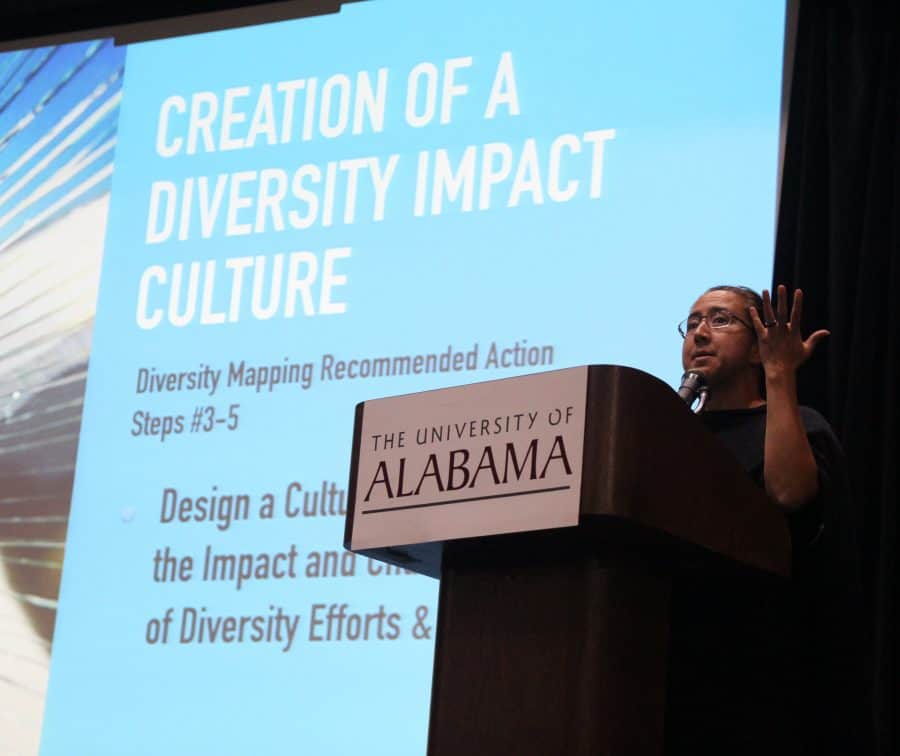In terms of diversity efforts, the University of Alabama is similar to other institutions, according to the findings from Halualani & Associates: their efforts are plentiful, but there is plenty of room to improve.
The group conducted a review for the University as part of the school’s strategic plan, and Rona Halualani, managing principal and co-founder of the firm, presented the findings in a presentation entitled, “Diversity Mapping: Key Insights for Action,” on Monday.
The firm assessed evolution of the University’s diversity practice and found, on a four-order scale, that the University fits into the second order. The first order is declaring diversity efforts and stating commitments to it. The second order is demonstrating commitment by action, effort or program. The third order is sustaining actions aligned with the strategic plans, and the fourth order is transforming cultural practices and diversity engagement on campus.
Within the period examined, the mapping found 1,695 different diversity efforts on campus, which Halualani said is a good amount of activity. Ninety-five percent of those efforts were centrally designed and created for the purpose of diversity, equity and inclusion.
“But here’s the thing about that, even though we found a lot of efforts, there was no strategic framing or alignment amongst those efforts,” she said. “So if I were to write each of those efforts, 1,695 of them, on separate index cards and threw them up in the air, they may very well land on the ground very much in a way that we saw them.”
Halualani said she would love for the University to come up with a strategy with stages, asking what students want to engage in their first year, in the middle years, toward the end, and after graduation.
The diversity mapping began in the summer of 2016 and took about eight to ten months. The mapping looks at the institution’s efforts, meaning it examines what was said to be done about diversity, equity and inclusion, and if the actions follow. The mapping tracked all diversity courses and diversity efforts – such as retention and graduation initiative, campus activities, programs, events, etc – from 2011 to 2016.
The firm reviewed all responses from the Diversity Efforts Informational Survey, examined hundreds of documents, the history of the student and local newspaper, and did a social media analysis for the mapping process.
The University wanted the diversity mapping done to show where it is with diversity and inclusion, since it is one of the four pillars of the University’s current strategic plan, said Associate Provost Jennifer Greer. She said the University wants this to be a planning tool for strategic action for the future.
Halualani recommends that the University get a new iteration of the diversity plan, one that is more focused and one that defines where the University wants to go next.
“A strategic vision is going to help define what you really want to do and not have you do things that you’re doing just because you’ve always done them,” Halualani said.
According to the findings, over half of the diversity efforts made are immediate, short term efforts. Only 43 percent of the efforts are expected to last longer than three years.
“Think about the sustainability of it,” Halualani said. “So, rather than embedding diversity efforts in a person or a group of people, it needs to be embedded in the infrastructure in a way that it is institutionalized for the long haul.”
Findings showed that efforts were made heavily on recruiting, but she said there are less retention efforts.
“What that means is you work really hard to get people into the door, but then in their first two years, if they don’t feel a sense of belonging then they’re out,” she said.
Forty-eight percent of diversity efforts were events, which Halualani said is the most common finding that the firm sees. All divisions evaluated on campus were supportive of efforts for increased diversity, equity and inclusion, according to the report, but the largest participating division – by far – was student affairs, which is usually what Halualani sees at institutions.
Halualani found different effort types in different divisions on campus, and found that when powerful conversations happened, they were mostly about race and gender. She said efforts were a blended focus, meaning 70 percent of them were targeted for specific groups.
“That doesn’t mean [the efforts] are exclusionary, what that means is, they are engaging historically underrepresented students, or female students, or international students, or students of color,” Halualani said. “They’re engaging different segments in different ways, so I thought that was a really robust, positive finding that there is focus on that, and I think that helps with historical under-representation in college completion.”
Diversity course findings reveal that international diversity is emphasized in curriculum, and that diversity efforts fill the gap on other diversity issues that are not in the curriculum.
The research showed the University is committed to offering diversity courses and there are enough faculty to teach the courses, but the actual curriculum within the courses needs more design work relating diversity, equity and inclusion.
“For me, the gold standard is how integrated your curricula is to diversity and inclusion topics, whether it’s content, settings, topics, or whether it’s pedagogical technique, and that’s what we looked at in relation to [the University’s] diversity courses,” Halualani said.
Moving forward, G Christine Taylor, vice president and associate provost of diversity, equity and inclusion, said she is requesting deans to form an academic diversity council among colleges at the University to help and focus on issues related to diversity, equity and inclusion.
She said she wants to connect the different pockets of excellence that the Capstone offers. She wants to look closely at being intentional and have specific goals that the whole institution works toward.
“I think it’s so very important to be collectively intentional about the work that we do around diversity and inclusion,” Taylor said.









